Rainbow warrior womb-one cabbage, I sing your praises.
I sing in color, fiercely, with savor and scent, as you do, oh cabbage, oh queen of the garden.
Purple, blue, green, white, and gold: Rainbow Woman, your colors are endless.
Oh yes, I sing your praises in glowing hues.
Leaf, flower, seed, and root; Warrior Woman, you give your all.
Oh, fiercely, I sing your praises.
Brussels sprouts, kale, rutabaga, radish, mustard, collards, bok choy, turnip, arugula, watercress, daikon, kohlrabi, collards; Great Mother, Womb-one Woman, your nourishing forms are infinite.
With sharp scents, I praise you.
Rainbow warrior womb-one cabbage, your powers amaze me.
I am in awe of your endless uses.
I am astonished by your shape-shifting abilities.
I grate your roots (horseradish or wasabi) and mix them with vinegar (or water) to make a thick sauce.
I gather your leaves.
I gather your leaves singly, in bunches, in heads.
I gather your leaves to my bosom. I take them to heart.
I harvest your heads of tightly-furled flower buds (broccoli, cauliflower), steam until tender, then saute with garlic in butter, oh my!
I grind mustard seeds into a condiment or turn them into a deadly gas.
Rainbow warrior womb-one cabbage, your stories are legion.
Babies are left – by a stork – under a cabbage leaf.
What is "kraut?" It is cabbage. As in sauer
kraut, fermented cabbage. Kraut is a cultivated plant, not a weed; a weed is
unkraut (not cabbage). Kraut becomes all edible plants as krauter, vegetable.
Four servings of cabbage family plants per week reduces cancer risk by half.
Cabbage family, mustard family, Brassicaceae, cole, Crucifera, cress.
Every name for you is a name of praise.
Rainbow warrior womb-one cabbage, all praise, all gratitude are your just rewards.
We are blessed by your presence in our lives.
Look around you. Green blessings (of a cabbage family sort) are everywhere!
.
Here is a small sampling of cabbage family plants whose seeds might be used as a condiment. Recipe follows.
Shepherd's purse (Capsella bursa pastoris)
This member of the cabbage family is easy to identify by its seed pods, which are in the shape of little heart-shaped "purses." The shadow photo and the flower photo are of a local species –
Capsella rubella – which is used in all the same ways as the
bursa-pastoris, which is in the third picture, showing off its ability to make seeds. This great bunch was growing next to the barn at an organic farm.
Midwives and menopausal women depend on tincture of the flowering top of fresh shepherd's purse to staunch uterine bleeding. It is prompt and effective in dropperful doses, under the tongue if needed, or desired, for fastest action. I occasionally eat the young leaves, when they look like miniature dandelion leaves and have a spicy, cabbagy taste. The tincture usually has a strong smell, like sauerkraut or cabbage.
The part of this common farm and city weed that is most often used, historically, is the seed. In times of need, it was collected and ground with wheat, or even used instead of wheat, to make bread. It is most unusual that a seed in the cabbage family can be eaten in quantity, most are best used as condiments, and may, even then, be problematic for some.
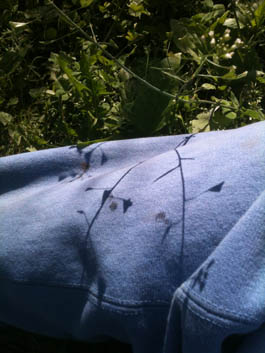
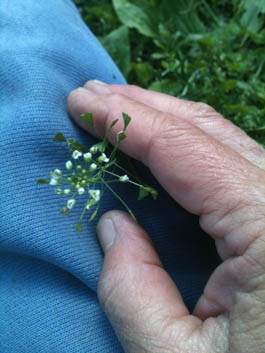
shepherd's purse in shadow shepherd's purse flowers
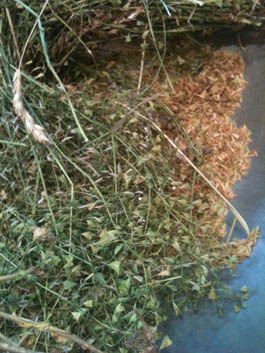
shepherd's purse seeds
Poor man's pepper, pepper grass (Lepidium virginicum)
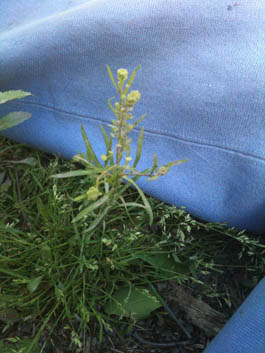 Pennycress (Thlaspi arvense)
Pennycress (Thlaspi arvense)
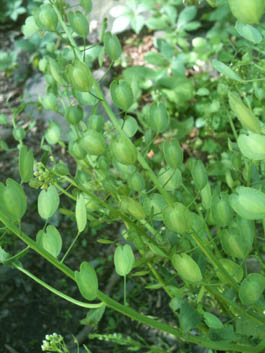
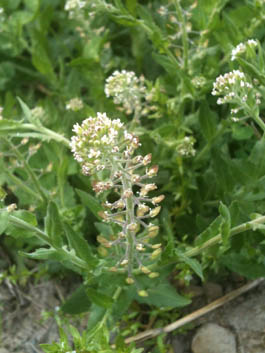
pennycress pennycress flowers
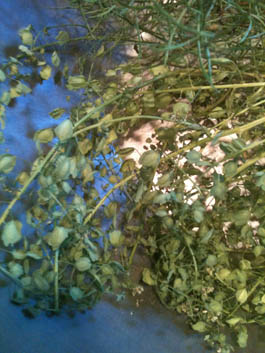
pennycress seeds
Cow cress (Lepidium campestre) is not photographed but is another peppery condiment.
The apprentices renamed "poor man's pepper" as "poor person's pepper" or "poor witches pepper," but you don't have to be poor to enjoy the spicy, peppery seeds of these cabbage family plants. They show up around me in great abundance around the middle of May, offering tasty leaves for my salads. By the beginning of June they are flowering and just beginning to set those breath-taking seeds. And they are so easy to use. You don't have to toast or crush them. Just separate the husks away and they are ready to use. Add a little spice to your life!
Barbara's cress, Winter cress, Yellow rocket (Barbarea vulgaris)
This is one of the first wild foods that I learned to recognize and use, but I must admit to never enjoying it. Winter cress is too bitter and acrid for my taste, and I am a great lover of cabbage family greens in all their forms. It is nice to know that it is virtually evergreen and thus provides greens for winter scavanging (so long as the snow is not too deep) I will eat the flowers in my salad and I am curious to see if the seed is usable as a condiment. And I continue to feel a special kinship with yellow rocket and to exalt when it covers fields and pasture lands with a sudden yellow wave.
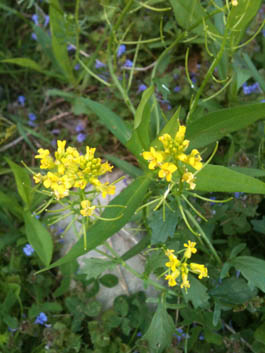
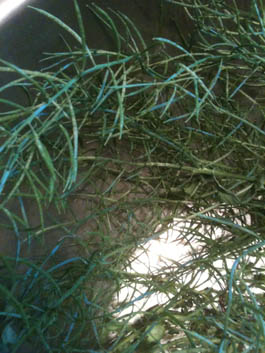
Barbara's cress in flower Barbara's cress seed pods
Wild Seed Condiment
I am especially respectful when harvesting the seeds of annuals. Though annuals do their best to make lots and lots of seeds, they are nonetheless vulnerable to extinction if there are wide swings in weather patterns. I take no more than one-third of what is available from any one plant or patch of plants.
To begin: Taste the leaves of any wild cabbage family plant. If they are tasty or peppery or cabbagy or mustardy, continue. If they taste bitter, find a different plant to harvest. (A few plants in this family have poisonous seeds. Those taste bitter. ) Shepherd's purse seeds are the one mostly commonly used for food purposes. I also enjoy "poor person's pepper" seeds prepared this way.
Then: Harvest a small amount of seeds, just a spoonful, at first. After your first batch, if you like Wild Seed Condiment, you can harvest larger quantities of seeds.
Most likely, you will have to separate the seeds from the inedible husks. Fortunately, there is no chaff, so separation can be done easily by hand.
Toast the seeds in a cast iron frying pan or in a toaster oven until they start to pop.
Crush seeds, using a pestle and a little sea salt, in a mortar.
Put in a shaker top jar and use.
Weed Walk
Plantain (Plantago)
What a Great Remedy! Plantain is our plant of the month for the mentored students.
Plantain is my go-to herb for any injury, bug bite, scratch, wound, bruise, scrape, tear, sprain, cut, or abrasion. It is positively amazing in its ability to stop itching, whether from a mosquito or flea bite, poison ivy, or any other irritant. Plantain works fast to counter reactions to bee and wasp stings. Some allergic friends say they keep dried plantain leaf on hand to try first, before resorting to their epi-pen, if stung. While plantain salve, ointment, and oil work well to counter rashes and skin irritations of all sorts, to counter allergic reactions to stings, the leaf must be chewed and applied directly to the wound. Directions for making a Fresh Herb Spit Poultice follow.
There are two different species of plantain where I live: the broad leaf (P. majus) and the narrow leaf (P. lanceolata). Both can be used for food and medicine. Some people believe the narrow leaf is a more potent medicine. I prefer the broad leaf, tender new leaves chopped fine, in my salads. The mentored students and I have been exploring plantain cuisine this month and we have found some tasty recipes indeed. Dear plantain, the peaceful Quaker lady who wants to help.
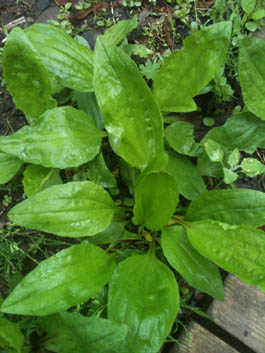
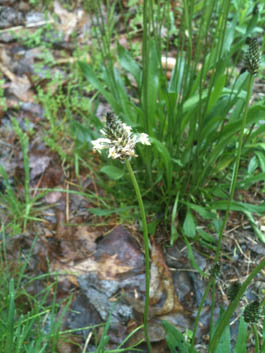
Broad leaf plantain Narrow leaf plantain
Yarrow (Achillea millefolium)
Madame Yarrow runs a school of self-defense. She may small, but she packs a punch. There are few bacteria – gram-positive, gram-negative, or antibiotic-resistant – that can resist her. I use yarrow tincture as an insect repellent as well as a wound treatment. A spritz or two on exposed skin keeps mosquitoes, black flies, and even the ticks at bay. Horses are so appreciative of a spray or two to discourage flies. Of course I use the fresh leaves as a spit poultice, but I prefer the flowering tops for tincture. Oh, and by the way, be sure to use the wild white yarrow, not yellow or red cultivars, which have poisonous amounts of volatile oils. The more you use yarrow, the more ways you will find to use her. She is truly one of the Great Remedies.
 Comfrey (Symphytum uplandica x)
Comfrey (Symphytum uplandica x)
Comfrey the comforting is one of my favorite herbs for tending to all injuries, whether external or internal. After surgery, after an accident, after bone has broken, comfrey is there to comfort and restore intregrity. (One of her old names is "knit-bone.") She strengths, knits, mends, and heals the skin, muscles, bones, ligaments, and tendons. She soothes, repairs, and nourishes the mucus surfaces of the respiratory, digestive, and reproductive systems. Oh, and, don't forget, comfrey contains a unique amino acid that is needed in the formation of short term memory. Comfrey makes everything in my body stronger, more flexible, and more cooperative. Is it any wonder I drink at least a quart a week of comfrey leaf infusion?

Fresh herb spit poultice
This type of poultice is immediate first aid for
bleeding wounds, stings, bites, itches, sprains, cuts, scrapes. . .
- Pinch off one or two medium-sized plantain leaves or
- Pinch or cut one large yarrow leaf from the bottom of the plant or
- Cut a piece of comfrey flower stalk or leaf petiole.
Chew the fresh plant material for 10-30 seconds.
Mix it well with your saliva. Apply to your boo-boo.
Or, have the injured person chew the fresh plant material and help them apply it.
Bleeding usually stops within 30-60 seconds.
Pain and itching is generally relieved within 10-30 seconds.
Hold spit poultices on with an adhesive bandage for long-term benefit.
I keep a spit poultice bandage on until the wound is well healed.

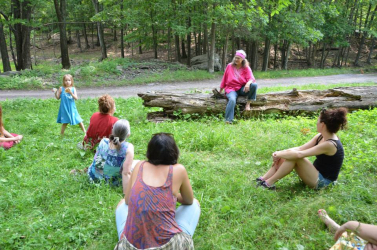 The Wise Woman Center exists to re-weave the healing cloak of the Ancients. This land is sacred, it is a safe space for women, and a place for the teachings of the Wise Woman way. The Goddess lives here, as do goats, fairies, green witches, and elders.
The Wise Woman Center exists to re-weave the healing cloak of the Ancients. This land is sacred, it is a safe space for women, and a place for the teachings of the Wise Woman way. The Goddess lives here, as do goats, fairies, green witches, and elders.


